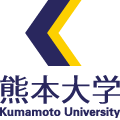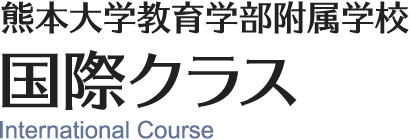- ホーム
- 教育方針
教育方針 Policy
国際クラスが目指す姿 / Aim of the International Course
■ グローバル人材の育成 / Development of global citizens
英語でのコミュニケーション能力を身に付け、主体的に豊かな人生を切り拓く、持続可能な社会の担い手として、自信をもって世界中の誰とでも協働・協力しながら新たな価値を創造したり課題解決に取り組んだりできる人材の育成を目指します。
We aim to develop students who can create new values and solve problems while collaborating and cooperating with people from different countries and cultures, who have acquired communication skills in English and proactively create a rich life as the builders of a sustainable society.
■ 地域社会への貢献 / Contribution to local society
ますますグローバル化が進展する地元熊本への教育の充実に貢献するとともに、公立小・中・義務教育学校における英語イマージョン教育のモデルの可能性を探り、先導的な役割を果たします。
Provide education that positively contributes to the ever-globalizing Kumamoto as well as exploring ways to further immersion education models at public elementary, junior high, and compulsory education schools.
国際クラスにおける教育方針(基本理念) / Basis Policy (Philosophy)
これまでの附属小・中学校の伝統や特色ある教育、強み等を生かしながら、児童生徒が外国語(英語・日本語)を多く使う環境の中で、日本の学習指導要領に沿ったカリキュラムに沿って、
- 身に付けるべき資質・能力の育成(学力の充実)
- 言語力の育成(英語及び日本語)
- 国籍や言語の壁を越えたグローバルマインドの育成
を目指します。
In an environment where students use foreign languages (English and Japanese) a lot while making use of the traditions, unique education and strengths of our school, and adhering to the guidelines in the national curriculum standards in Japan, we will aim to:
- Foster academic qualities and abilities
- Develop language skills (English and Japanese)
- Cultivate a global mindset that transcends nationality and language barriers
◆目指す児童生徒像 / Image of Students We Aim for
以下の力を身に付けた児童生徒
○ 確かな学力(学習指導要領に示された身に付けるべき資質・能力)
○ 世界中の人々と自信をもって複数言語(英語・日本語)でコミュニケーションを図ることができる高い言語力
○ 国際的な視野をもち、国籍や言語の壁を越え、主体的に誰とでも前向きに協働・協力しながら課題解決に取り組もうとすることができる力
We aim to develop the following competencies in our students.
- Strong academic skills (as laid out in the curriculum standards).
- Being able to communicate confidently at a high level with people all over the world in English and Japanese.
- Ability to work proactively with anyone to solve problems in a positive and cooperative manner having international perspectives and transcending nationality or language barriers.
◆教育課程編成・実施方針 / Curriculum Management・Implementation Policy
○ これまでの附属小・中学校の伝統や特色ある教育、強みを生かしつつ、より言語能力の向上を目指した教育課程を編成します。
○ 日本人及びネイティブ教員の二人体制をはじめとする指導体制の充実や、実態に応じた指導方法・学習形態等の工夫により、個別最適な学びと協働的な学びの一体的な充実を図り、個々の力を高めます。
○ 多くの教科や学校生活の中で英語に自然に触れ、実際に使う環境を整えるとともに、確実な英語力の向上につながる取組を実践します。
○ 国語や道徳をはじめとした、日本語能力の育成にも重点的に取り組みます。
○ 学校行事はもとより、一部の授業においても一般クラスとの交流も図り、学校全体への国際化に資するとともに、国際クラスで学んだことや身に付けた力を生かす場を多く設けます。
- Create a curriculum that develops students’ language abilities while respecting the traditions and uniqueness of our school.
- Enhance individual and cooperative learning and develop individuals’ abilities in an integrated manner including a two-person system of Japanese and native English teachers, and by devising teaching methods and learning styles according to the actual conditions.
- Create an environment in which students are naturally exposed to and able to use English in various subjects and school life and implement measures that will lead to a steady improvement of English language skills.
- Focus on the development of Japanese language skills including Japanese as a language and moral education.
- Aim to give students chances to interact with students in the general course in some classes and school events to contribute to the internationalization of the school as a whole, and allow students to utilize what they have learned and acquired in the international classes.
<<━━━━━━━━━━
本学教育学部附属学校の国際クラスにおいては、外国語(日本人児童生徒にとっては英語、外国人児童生徒にとっては日本語)に多く触れる環境の中で、言語能力を自然に身に付けるとともに、主体的に学び、仲間と協働しながら学びを深める中で、互いを認め合い、尊重し合いながら、グローバルな視点と外国語(英語・日本語)という強みをもち、自信をもって社会で活躍できる人材の育成を目指します。
令和8年度に小学校において全学年で一斉に国際クラスをスタートするため、開設時からしばらくの間は、小学校第2学年以上、特に高学年に在籍する児童については、言語の習得状況や外国語での学習経験が不十分な状況の中での実施となります。そのため、学年や実態によって使用する英語の量や質、目標とする国際クラス設置後の3、4年間の学修成果は学年間で異なることが予想されます。(小学校第1学年から6年間積み重ねた児童の習得する言語力及びその言語を運用しながら相手と意思疎通をはかるコミュニケーション能力と、高学年から始めた場合のより限られた期間で習得するそれらは、大きく異なるということが、これまでの教育研究の知見から予想されます。)
よって、英語による授業やその他の教育活動の実施に当たっては、国際クラス開設後当面の間は一般的にいう「イマージョン教育の運営の仕方」と本校におけるそれとは必ずしも一致するものではないことをご理解いただきたいと考えています。ただし、前述したように、国際クラスにおいては日本人及び外国人の児童生徒と教員が常に存在し、英語を実際に使いながら学習したり、生活したりすることになるため、各学年の子どもの発達レベルに合わせて、母語と外国語を学びコミュニケーション力を発揮できるように、イマージョン環境を授業場面でも学校生活全般にわたっても充実させて参ります。
(注)本学教育学部附属学校国際クラスにおいては、英語または日本語を母語としない児童生徒も在籍することが想定されます。その場合、それぞれの母語習得・保持への支援など、各家庭での適切な言語教育環境も必須です。
At the International Course of the Kumadai Fuzoku Schools, students will be immersed in an environment where they are extensively exposed to foreign languages—English for Japanese students and Japanese for international students. Through this exposure, they will naturally acquire language proficiency while actively engaging in learning and collaborating with their peers. This process fosters mutual recognition and respect, equipping students with a global perspective and strong foreign language skills (English and Japanese), enabling them to confidently contribute to society.
Implementation Considerations for the Initial Launch of the International Course
The International Course will officially launch across all elementary school grade levels in the AY2026 (Reiwa 8). However, during the initial years, students in Grade 2 and above, particularly those in upper grades, will be entering the program without having fully developed foreign language skills or prior experience learning subjects in a foreign language. As a result, the amount and complexity of English used, as well as the expected academic progress over the first three to four years, will vary by grade levels.
Educational research suggests that students who begin immersion education from Grade 1 and continue for six years develop significantly different language proficiency and communication skills compared to those who start in upper elementary grades with a shorter learning period. Therefore, during the initial phase of the International Course, the way immersion education is implemented at our school may differ from the conventional immersion education model.
Nevertheless, as previously mentioned, the International Course will always include both Japanese and international students learning alongside teachers in an environment where English is actively used in both academics and daily life. To ensure that students of all grade levels can develop both native and foreign language proficiency while enhancing their communication skills, we will continue to create a rich immersion environment that extends beyond the classroom and into all aspects of school life.
Note: The International Course is expected to include students who are neither native English nor native Japanese speakers. In such cases, it is essential for families to provide appropriate language support at home to aid in the acquisition and maintenance of the student’s native language.

